Tapestry Fabrics for Vestments: How to Measure Pattern Repeats
Tapestry Fabrics for Vestments: How to Measure Pattern Repeats
Tapestry Fabrics
Tapestries – they are a thing of beauty, steeped in history reminding us of tales almost forgotten in the recesses of the mind: of knights and chivalry and castles of ages long past. Tapestries are indeed items with a rich history. They were once the hangings used on the walls of castles great and small to keep out drafts and the cold. They were rich in color and style variations as well as detail. Yet we still use tapestry fabrics for vestments today in the life of the church, albeit for somewhat different purposes.
Weaving Tapestry Fabrics
Tapestry fabrics used in churches today are woven into a rich palette of colors and patterns to delight the eye. The fabric is by nature a bit heavier than most liturgical brocades. And such rich detail – often like pictures. This detail requires the use of many threads or yarns in the weaving process. When yarn is needed for design detail, the loom pulls that yarn to the surface of the fabric. Once the detail is woven, the yarn returns to the underside of the fabric and is floated across the back surface or woven along the back side until it is needed again.
There are multiple colors of yarns being woven above and below the surface at any given inch of liturgical tapestry fabric. This is why tapestry fabrics for vestments have a heavier feel to them when compared to other fabrics that have only a single warp and weft yarn. Tapestry is like a painting. The detail that can be achieved is incredible. 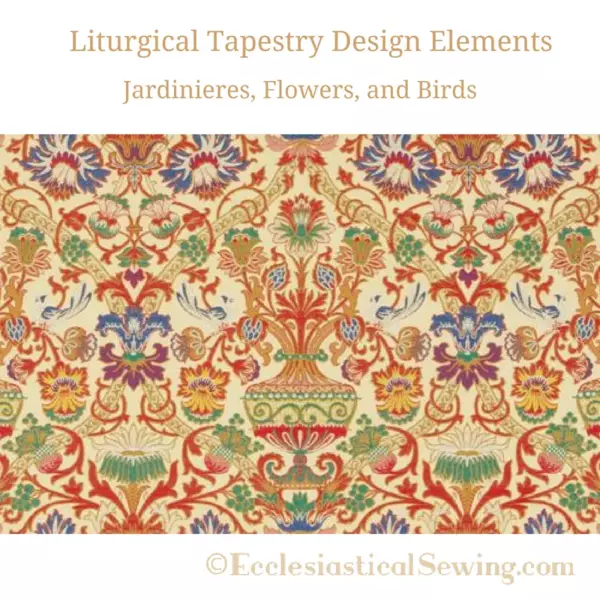
Main Design Elements of Tapestry Fabrics
Many liturgical tapestry fabrics have similar design elements which include the Jardiniere, flowers, vines, and birds. The Jardiniere is a large pot of some sort. In tapestry fabrics, the pot is decorated with swirls, dots, and all sorts of elegant design elements in varying colors. Stems and vines grow out from the mouth of the Jardiniere and create stunning floral displays. Perched on either side of these floral arrangements are two birds which in some historical books are described as the mediators between heaven and earth. Between each Jardiniere are stylized Fleur de lis motifs which are sandwiched between more floral motifs both above and below.
Pattern Repeat
Once one takes a closer look at tapestry fabrics for vestments or any liturgical fabric, one quickly notices specific design elements that repeat horizontally as well as vertically along the fabric. So knowing there is a pattern, how does one determine the size of the pattern repeat? The simplest way to start breaking down the pattern repeat is to pick a design element. For the sake of simplicity, let’s select the bottom of the Jardiniere (represented by the purple lines in the above photo).
Starting at the bottom of one Jardiniere, follow the pattern down the length of the fabric until you come to the bottom of the next Jardiniere. This is where the line is placed. Then take a tape measure and measure the distance between the two lines. This measurement is the lengthwise pattern repeat for this fabric. The same process can be followed going across the fabric as well.
Before diving in on a project that involves cutting a complicated pattern repeat, take some to study and learn the fabric. In the Ecclesiastical Sewing Studios, I do this by leaving a fabric out in a safe place for several days. I sit and look at the various design elements of the fabric and see where the next repeat is. One can also cut a paper window or mat frame and place that around the fabric in various areas. Using a paper frame or matting frame helps one see what is a pleasing arrangement for use on smaller vestment items such as stoles.
The Complexity of Tapestry Fabrics
Learning the fabric patterns and motifs, and knowing where and how they repeat over the fabric removes that element of fear. So often fear holds us back and prevents us from tackling these seemingly “complicated” projects. Tapestry fabrics are a true joy to use, once one becomes familiar with them. Now, having said that I do not recommend tapestry fabrics as a first project. These are fabrics that can be handled but first. Give yourself the time to gain skills with simpler projects, working up to these fabrics.
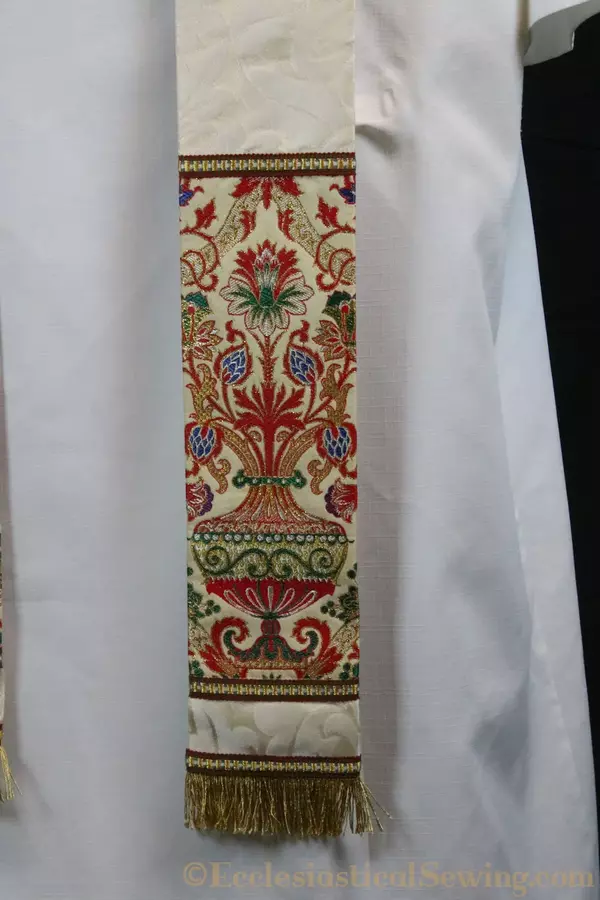 Tapestry Design Details
Tapestry Design Details
The Jardiniere was selected as the design element for use on this stole. The size is perfect for the stole width. The height of the flower as the vines close over the top is the perfect cut-off for the stole orphrey band. There are several other design motifs within the fabric that would work equally as well for stole orphrey bands if one does not care for the Jardiniere design. And of course, smaller design elements can always be determined after larger pieces are cut.
Aragon Tapestry
The tapestry pictured in the photos in this post is the Aragon Pattern of tapestry. It comes in two colorways: red predominate and green predominate. Each color is available in a plain version and in a lurex version. The Lurex version has a metallic yarn that has been included in the weaving process to add a bit of shimmer to the final fabric. Aragon Tapestry is appropriate for use in making chasubles, copes, stoles, altar hangings, and many other church vestment items. It cuts well into orphrey bands which minimizes waste.
So, which tapestry fabric is your favorite? Have your say below.
Soli Deo Gloria
Ecclesiastical Fabric Pattern Repeats
Dainty Liturgical Fabrics? How Will They Look!
Dainty Liturgical Fabrics? How Will They Look!
Aragon Liturgical Tapestry Fabric in Red Lurex
Creating Orphrey Bands for Church Vestments
Dainty Liturgical Fabrics? How Will They Look!
Simple Details

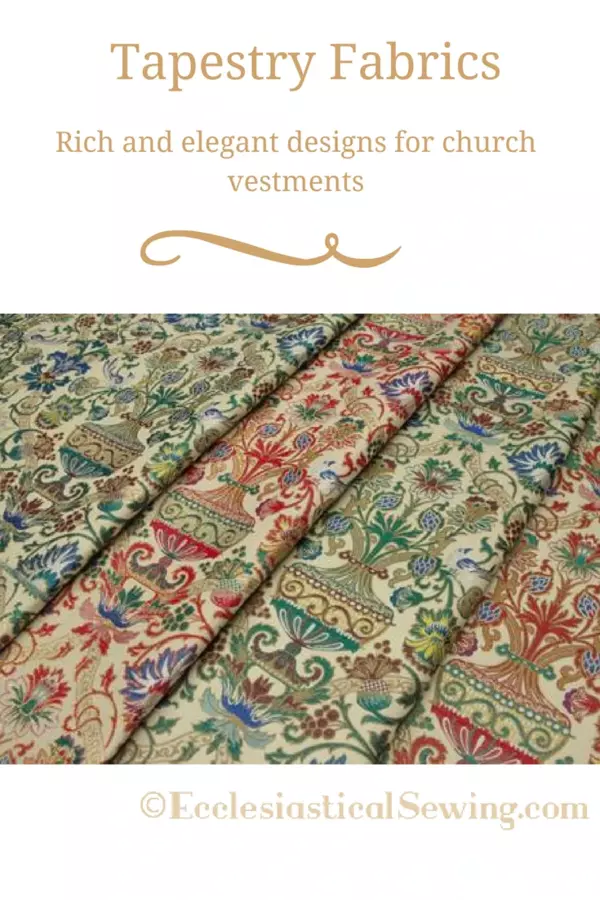


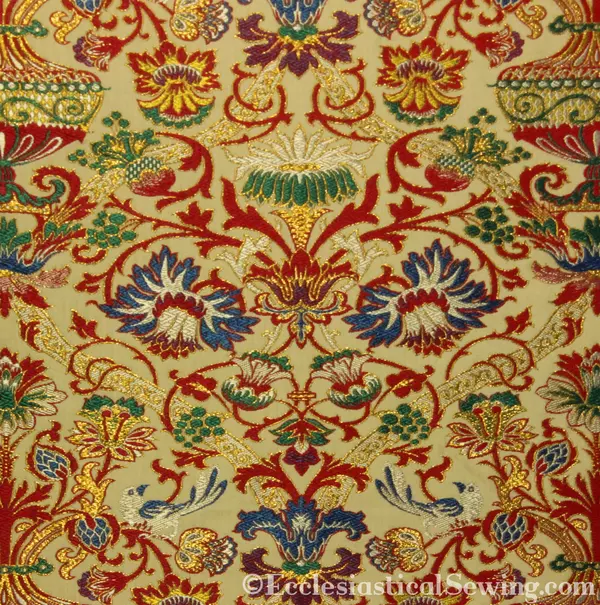
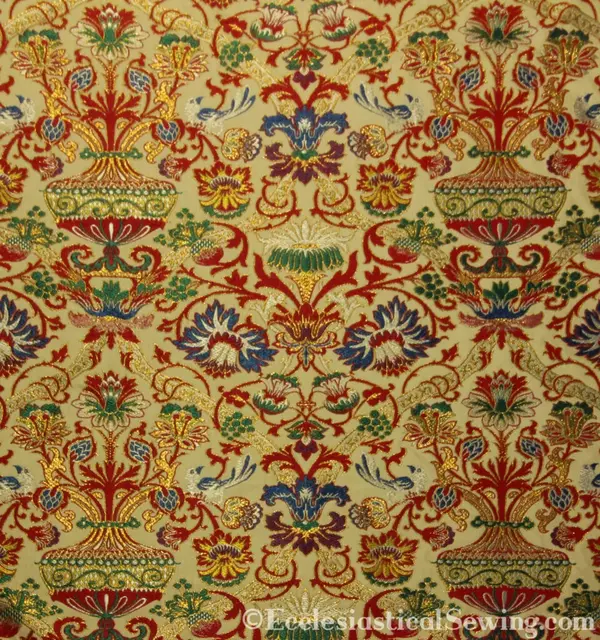





 RSS - Posts
RSS - Posts
You must be logged in to post a comment.